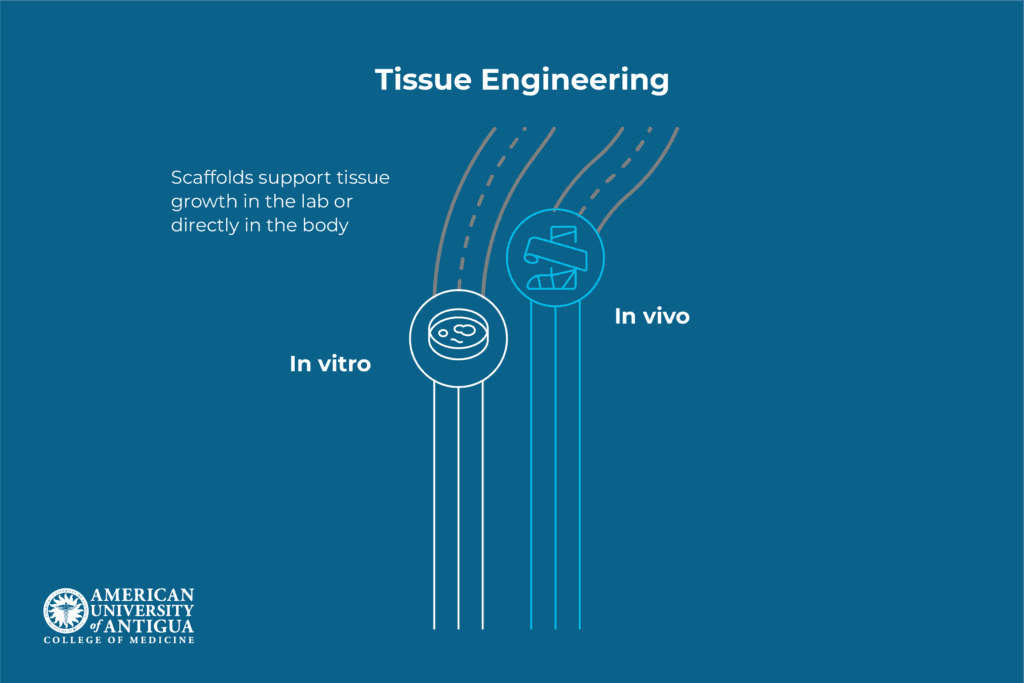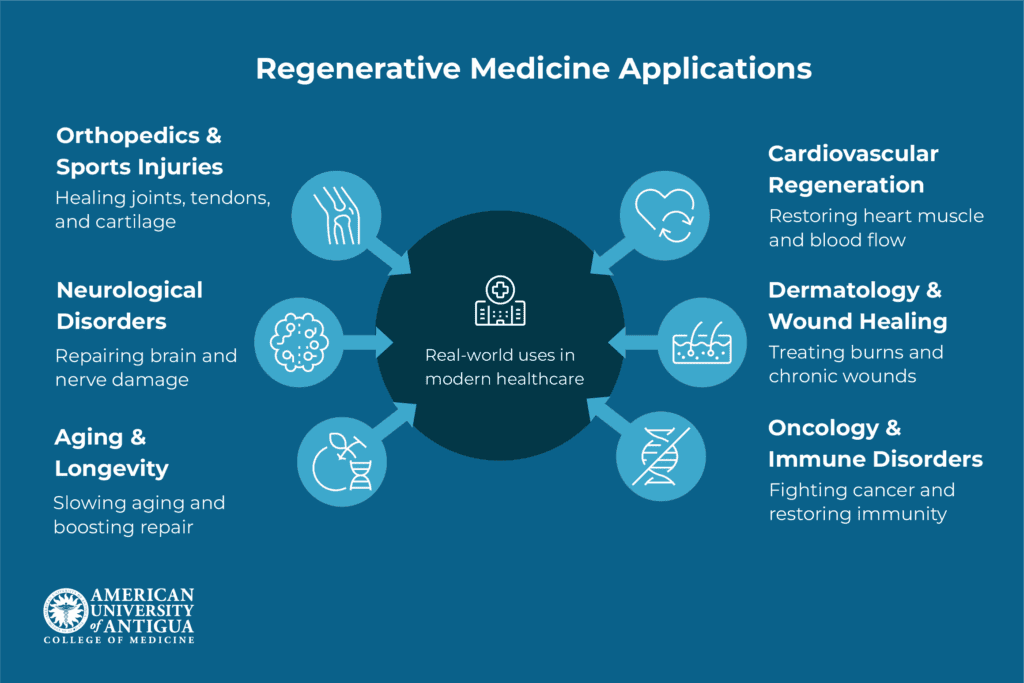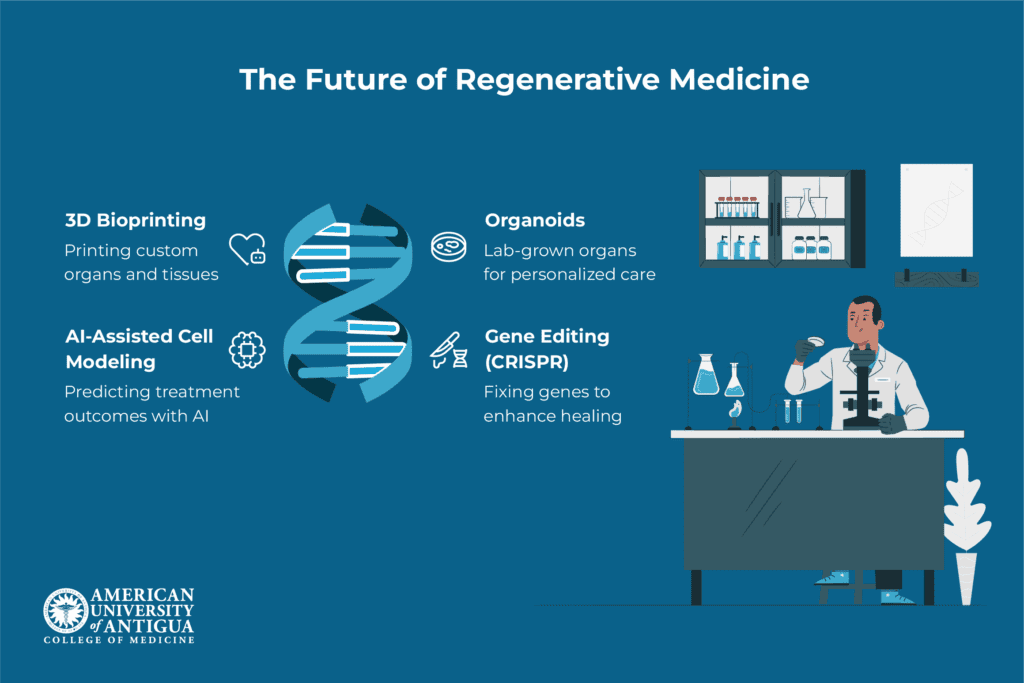What Is Regenerative Medicine? Treatments & Future Insights
Key Takeaways
- Regenerative medicine is changing healthcare by helping repair or replace damaged tissues and organs and offering new ways to treat long-term diseases, injuries, and aging problems.
- Stem cells and tissue engineering play a significant role in regenerative medicine, helping the body heal by creating new tissues and repairing damaged areas using scaffolds and lab-grown cells.
- Regenerative treatments are used in real-life healthcare for joint problems, heart issues, nerve damage, and skin injuries, often providing a better alternative than traditional treatments or surgery.
- New technologies in regenerative medicine, like 3D printing of tissues, lab-grown organs, AI-guided treatments, and gene editing, will make treatments more accurate, easier to access, and more effective in the future.
One of the most fascinating areas of contemporary medicine is regenerative medicine, which helps replace, repair, and heal damaged tissues and organs. As populations age and the prevalence of chronic diseases increases, there is a growing need for longer-lasting, more effective treatments.
Regenerative medicine uses cutting-edge techniques like tissue engineering, gene editing, and stem cells to help the body repair in ways that were previously impossible. In this blog, we’ll explore how this works, the main technologies behind it, and where it’s being used today.
✅ Request information on AUA's MD program TODAY!
YOUR PATH TO SUCCESS BEGINS HERE
What Is Regenerative Medicine?
Replacing or repairing damaged, injured, or malfunctioning parts of the body is the aim of regenerative medicine, a relatively new and exciting area of medicine. By treating the underlying source of the problem rather than just its symptoms, it aids in the body’s natural healing process.
Genetics (the study of genes), material science (the study of materials and how they can be used in the body), biomedical engineering (the application of engineering to medical problems), cell biology (the study of how cells function), and many other disciplines share resources and knowledge in this type of medicine.
Regenerative medicine has the potential to transform the way we treat chronic illnesses, severe injuries, and other health problems by promoting the body’s natural and long-lasting healing process through techniques like stem cell therapy, tissue engineering, and gene editing.
How Regenerative Medicine Works

Regenerative medicine helps the body heal by either waking up its natural repair system or adding new, healthy cells or tissues to fix what’s damaged. This can occur in one of two main ways. The first way to assist the body in healing itself is endogenous repair stimulation, which uses specific signals or therapies to instruct the body to produce new, healthy cells.
Exogenous tissue replacement is the second method, which involves injecting lab-grown cells or tissues to replace injured body parts. These treatments can be made from living cells, tissue pieces, or even genes that aid healing. Sometimes, doctors combine different types of treatment to help speed up the healing process.
Stem cells
Special cells called stem cells have the ability to develop into a wide variety of cell types. They are significant because of two key characteristics. Self-renewal is the first, meaning they can replicate themselves. Second, they have the ability to differentiate into different kinds of cells, such as brain, muscle, or skin cells.
Regenerative medicine uses stem cells to help repair or replace damaged body parts.
There are three primary categories:
- Embryonic stem cells (ESCs)
- Adult stem cells (ASCs)
- Induced pluripotent stem cells (iPSCs)
Embryonic stem cells (ESCs) are controversial because they originate from early-stage embryos and can develop into nearly any type of cell.
Adult stem cells (ASCs) are found in body parts like bone marrow and fat. They can’t become as many types of cells as ESCs, but they are easier to use and less debated.
Induced pluripotent stem cells (iPSCs) are regular adult cells that scientists have changed to act like embryonic stem cells. This gives them many uses without the same ethical concerns. Stem cells help heal by joining the body’s repair process and turning into the needed cells.
Tissue engineering

Tissue engineering is a part of regenerative medicine that focuses on creating or repairing body tissues. It often uses scaffolds, special structures that give cells a place to grow. These scaffolds can be made from natural or manufactured materials and help guide new tissue growth.
Common materials used include collagen (a protein found in skin and other tissues), hydrogels (gel-like materials that hold water), biodegradable polymers (materials that safely break down in the body), and smart biomaterials that can react to signals in the body to support healing.
Tissue engineering can work in two main ways. It can grow tissue outside the body (in vitro) in a lab and then be placed into the body. It can also be done inside the body (in vivo), where the scaffold is placed directly into the damaged area to help the tissue grow there. Both methods help the body heal by building or replacing damaged tissues in a natural and helpful way.
Gene therapy in regeneration
Gene therapy is a way to treat or help the body by changing or adding genes inside a person’s cells. In regenerative medicine, gene therapy helps the body heal by encouraging cells to grow, repairing damaged tissues, or turning regular cells into ones that can help heal. It can also help the body make more specific proteins or growth factors that support recovery.
To get these helpful genes into the cells, scientists often use viral vectors—which are harmless viruses like lentivirus or AAV that can carry the genes safely into the body. There are also non-viral methods that use plasmids (small loops of DNA) or nanoparticles to deliver the genes. With gene therapy, the body gets extra tools to fix itself in a natural and powerful way.
Regenerative Medicine Applications

Regenerative medicine is not just being tested in research labs—it is now used in real hospitals and clinics to treat patients. Doctors are using it in many areas of medicine to help people heal from injuries, deal with long-term illnesses, and even restore damaged organs or body parts. It’s already making a big difference in fields like bone and joint care, heart disease, brain and nerve problems, and wound healing.
In the next few paragraphs, we’ll look more closely at how regenerative medicine is used in different healthcare systems today.
Orthopedics and sports injuries
Orthopedic tissues, like cartilage, tendons, and ligaments, are often treated with regenerative medicine because they heal slowly and can be damaged over time. These tissues don’t always heal fully after injuries, which is why regenerative treatments are so important in orthopedic care.
Some common treatments include mesenchymal stem cells (MSCs), which help repair damaged cartilage, and platelet-rich plasma (PRP), which uses the patient’s own blood to speed up healing. Sometimes, these treatments are combined with scaffolds to help the tissue grow back.
Regenerative therapies are often used to delay or even avoid surgery, especially for conditions like osteoarthritis or tendon tears. These treatments are commonly used for sports injuries, early joint problems, and long-term inflammation, helping people heal immediately without needing surgery.
Cardiovascular regeneration
The heart has a limited ability to heal itself, making it an important area for regenerative treatments. After a heart attack, the heart muscle often can’t repair itself, so regenerative medicine is used to help it recover. Stem cells can be used to help fix the damaged heart tissue and encourage the growth of new muscle cells.
Gene therapy and biomaterials are also used to help grow new blood vessels and reduce scar tissue after a heart attack. Unlike regular treatments that control symptoms, these therapies aim to restore the heart’s ability to work properly and help patients recover more fully.
Neurological disorders
Nerve and brain tissue don’t heal easily, which makes treating neurological disorders an important area for regenerative medicine. Some of the main problems being targeted are spinal cord injuries, Parkinson’s disease, and stroke recovery, where damage to nerves can cause long-lasting issues.
Researchers are looking at ways to use neural stem cells to repair damaged nerve pathways and gene therapy to help the healing process. They’re also exploring neurotrophic factors, which are proteins that help nerve cells grow and stay healthy. These treatments aim to restore lost functions and help people with neurological conditions recover better.
Dermatology and wound healing
In dermatology, regenerative medicine is used to help heal skin injuries like burns and chronic wounds (such as diabetic ulcers) that heal very slowly. Skin grafts are often used to cover and protect the damaged areas, while stem cells help grow new skin tissue.
Growth factors, which are natural proteins that help with healing, are also used to speed up the repair process. This is one of the most advanced and widely used areas of regenerative medicine, providing real treatments for people with severe skin injuries or wounds that don’t heal well with regular care.
Aging and longevity
Regenerative medicine is being used to help with problems caused by aging, like joint breakdown, skin aging, and declining organ function. As we get older, our bodies don’t heal as easily, leading to these common issues.
New treatments are being developed to fight this by focusing on cell rejuvenation, which helps restore younger, healthier cells; mitochondrial repair, which boosts energy in cells; and systemic regeneration, which helps the body heal and renew itself overall. These treatments aim to slow aging and improve how well our body can repair itself as we age, helping us live longer and healthier lives.
Oncology and immune disorders
Regenerative medicine helps with immune system recovery after treatments like chemotherapy or bone marrow transplants, which can weaken the immune system. It also helps repair tissue damage caused by cancer treatments, speeding up recovery and reducing long-term damage.
One promising treatment is CAR-T cell therapy, which combines both immune support and tissue repair. This therapy helps the immune system fight cancer and also encourages healing, making it a powerful treatment for both cancer and immune system problems.
The Future of Regenerative Medicine

The future of regenerative medicine is full of exciting new technologies that could greatly improve healthcare. 3D bioprinting is allowing scientists to print tissues and even organs, creating custom-made ones for each patient. Organoids—tiny, lab-grown versions of organs—are being used to design personalized treatment plans, making sure each patient gets the best care possible.
AI-assisted cell modeling will help doctors predict how treatments will work, making them more precise and effective. Gene editing tools like CRISPR could also improve healing by fixing genetic problems directly. These advancements will make treatments more accurate, easier to access, and better overall, giving hope for more effective regenerative medicine in the future.
Conclusion
Regenerative medicine is transforming healthcare by offering innovative ways to repair and replace damaged tissues, using technologies like stem cells, tissue engineering, and gene therapy.
These advancements are already helping patients across various medical fields, from orthopedic care to neurological treatments. As future technologies like 3D bioprinting and gene editing continue to develop, the potential for even more effective therapies grows.
To explore how regenerative medicine is shaping the future of healthcare, check out the cutting-edge medical programs at AUAMED.
Frequently Asked Questions (FAQs):
What is the difference between traditional medicine and regenerative medicine?
Traditional medicine focuses on treating the symptoms and managing diseases, while regenerative medicine aims to heal or replace damaged tissues to restore function.
Is regenerative medicine covered by insurance?
Regenerative medicine coverage by insurance varies, with some treatments being covered and others not, depending on the insurance provider and treatment type.
✅ Request information on AUA's MD program TODAY!
YOUR PATH TO SUCCESS BEGINS HERE
✅ Request information on AUA's MD program TODAY!